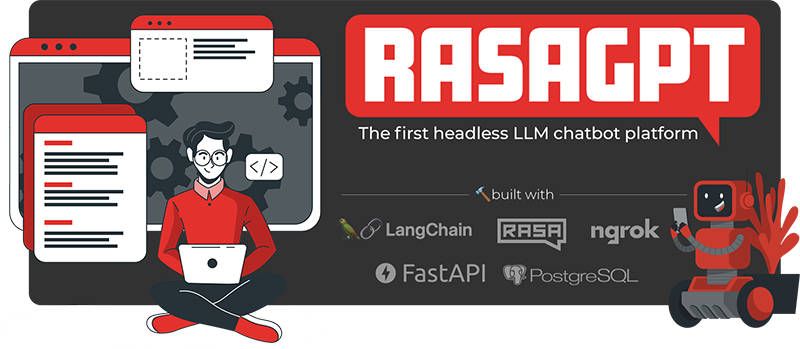RasaGPT - Headless LLM chatbot platform using ngrok + Telegram bot
-
 Overview
Overview RasaGPT is the first headless LLM chatbot platform built on top of Rasa and Langchain. It is boilerplate and a reference implementation of Rasa and Telegram utilizing an LLM library like Langchain for indexing, retrieval and context injection.
RasaGPT is the first headless LLM chatbot platform built on top of Rasa and Langchain. It is boilerplate and a reference implementation of Rasa and Telegram utilizing an LLM library like Langchain for indexing, retrieval and context injection. Resources: https://rasagpt.dev
Resources: https://rasagpt.dev- 🧑
 Github: https://github.com/paulpierre/RasaGPT
Github: https://github.com/paulpierre/RasaGPT - 🧙 Author: @paulpierre
 What is Rasa?
What is Rasa?In their own words:
 Rasa is an open source (Python) machine learning framework to automate text- and voice-based conversations: NLU, dialogue management, connect to Slack, Facebook, and more - Create chatbots and voice assistants
Rasa is an open source (Python) machine learning framework to automate text- and voice-based conversations: NLU, dialogue management, connect to Slack, Facebook, and more - Create chatbots and voice assistantsIn my words:
Rasa is a very popular (dare I say de facto?) and easy-enough to use chatbot framework with built in NLU ML pipelines that are obsolete and a conceptual starting point for a reimagined chatbot framework in a world of LLMs.

 ️ Why RasaGPT?
️ Why RasaGPT?RasaGPT works out of the box. A lot of the implementing headaches were sorted out so you don’t have to, including:
- Creating your own proprietary bot end-point using FastAPI, document upload and “training” 'pipeline included
- How to integrate Langchain/LlamaIndex and Rasa
- Library conflicts with LLM libraries and passing metadata
- Dockerized support on MacOS for running Rasa
- Reverse proxy with chatbots via ngrok
- Implementing pgvector with your own custom schema instead of using Langchain’s highly opinionated PGVector class
- Adding multi-tenancy (Rasa doesn't natively support this), sessions and metadata between Rasa and your own backend / application
The backstory is familiar. A friend came to me with a problem. I scoured Google and Github for a decent reference implementation of LLM’s integrated with Rasa but came up empty-handed. I figured this to be a great opportunity to satiate my curiosity and 2 days later I had a proof of concept, and a week later this is what I came up with.

